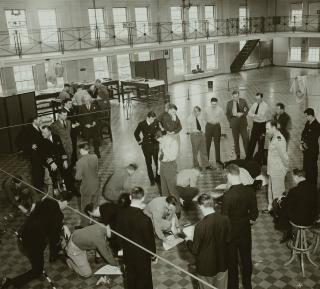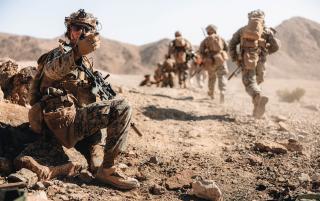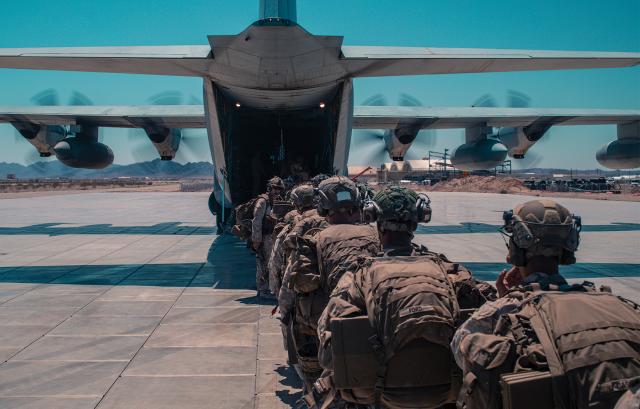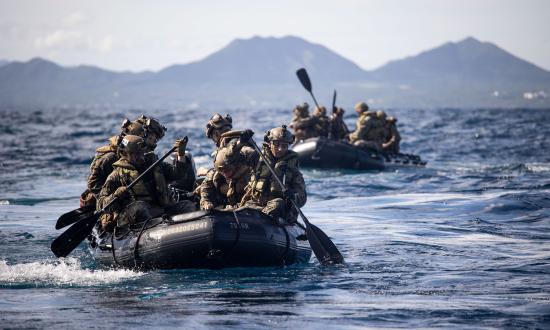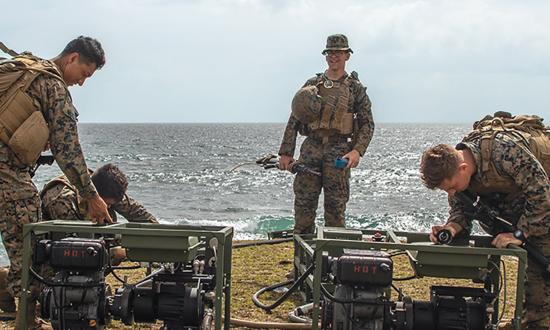Geopolitical changes require shifts in strategy. The post–Cold War era is over, and the international order established and protected by the United States and its allies is being challenged by revisionist powers, rogue nations, and nonstate actors alike. While maintaining a traditional global structure that secures stability, peace, and prosperity remains the United States’ primary strategic end, the military means to achieve it must shift.
The Marine Corps faces a strategic imperative to design a modern fighting force, learn through experimentation, and refine its organizational construct at the speed of a transforming strategic context. To achieve this, maneuverist thinking must be applied at the institutional level. Antiquated, slow, and sequential processes will not measure up.
The Road to Experimentation
Assessing its own capabilities, the Marine Corps recognized the demands of this new reality. In 2017, General Robert Neller’s final annual report to Congress noted the service was “not organized, trained, equipped, or postured to meet the demands of the rapidly evolving future operating environment.”1 The proliferation of long-range precision sensing and fires complexes, miniaturization and ubiquity of once exquisite combat systems, and changes to command-and-control capabilities had changed the character of war.
The recent Russo-Ukrainian war substantiates this. Preliminary reports discuss the decisiveness of precision fires, the omnipresence of electromagnetic warfare, the requirement for pervasive counter–unmanned aerial systems, and the obligation to disperse.2 The world and war have evolved, and the Marine Corps must evolve with them.
The challenge is how. The first step, already taken, was instilling a sense of urgency across the force. Force Design 2030 (FD2030) drove the Marine Corps with a clear vision of the future, challenging mindsets from senior leaders and the supporting establishment to the Fleet Marine Force rank and file. The initiative laid out a plan for modernizing the force, inspiring ownership and action throughout the service.
FD2030 is the blueprint for adapting and innovating faster than America’s adversaries, but providing crisis response today and achieving success on future battlefields requires iteration and testing in realistic scenarios. Propelled by the need to adapt and to get it right, the Marine Corps Warfighting Laboratory (MCWL) has brought forward its lessons learned since the 1997 Hunter Warrior experiment series and synthesized them with the learning demands of the current operating environment.
MCWL focused on experimentation along multiple lines of effort and with different combat formations. The past three years have seen strategic experimentation with purpose-built naval task forces, operational-level experimentation with the Marine littoral regiment (MLR), tactical experimentation with the redesigned infantry battalion, and broader conceptual experimentation with the future of logistics. Through these efforts, MCWL—working with and through the total force—has generated a body of analytical evidence to validate much of FD2030’s claims and assumptions.
U.S. Navy Interwar Experiments
This moment in history is not unprecedented. The character of war has changed before, and the service was forced to adapt. Reminiscent of today’s challenges is the development of an amphibious assault capability during the interwar period.
The Navy led the other U.S. services during the interwar period with wargames, experiments, fleet exercises, and concept development. In Learning War, author Trent Hone describes that Navy as an adaptive learning system focused on developing a common understanding of the essential problems of fleet battle among the next generation officer corps.3
The Naval War College class of 1932 spent 303 of 323 total instruction days on wargaming. These wargames often translated into experimentation with new concepts and fleet tactics during the annual Fleet Problems. The Navy allocated generous funding for these large-scale experimental exercises, during which many of the concepts, technological capabilities, and tactics, techniques, and procedures were practiced and refined prior to executing them in the “next war.”
One example of the new concepts and capabilities that were experimented with and yielded strategic effects in the next war is the Higgins boat.
Following World War I and during most of the interwar period, the prevailing thought among many military theorists was that amphibious landings were no more effective a means of waging war than horse cavalry charges. In an article in Naval History, author Richard Frank describes the view of military theorist B. H. Liddell Hart, who in 1939 claimed: “A landing on a foreign shore in the face of hostile troops has always been one of the most difficult operations of war. It has now become almost impossible.” Nevertheless, by the end of the war in 1945, the Marine Corps and Navy had transformed not only the “impossible” operations of amphibious landings, but also the very nature of modern warfare.4
Many years of Navy–Marine Corps experimentation were required to develop the prewar landing craft that were the genesis of the Marine Corps’ specialized armed and armored landing craft. Eventually, in 1926, Andrew Higgins emerged as a leading boat designer, and his “Eureka” craft evolved into a series of landing craft such as the landing craft, vehicles and personnel (LCVP or Higgins boat), the landing craft, mechanized (LCM), and the landing vehicle, tracked (LVT or AMTRAC).5 The combination of industrial innovation, military leaders’ willingness to experiment, and generous congressional funding solved a problem once thought impossible and became a catalyst for success in both the European and Pacific theaters of war.
Experimentation Operationalized
Perhaps the strongest evidence of the Marine Corps’ force transformation is that experimentation is occurring not only in training exercises and testing environments, but also during military operations, activities, and investments abroad. Conducting experimentation in this manner facilitates faster and more efficient learning and adaptation than relying on training venues alone.
In April 2021, as part of FD2030, using the capabilities resident in the Fleet Marine Force and with MCWL support, II Marine Expeditionary Force (MEF) and the 2d Marine Division sought to “accelerate experimentation with maritime, multidomain, reconnaissance constructs and activities to enhance the ability of the Stand-in Force to dominate the information environment, sense and make sense of the situation, and win the recon vs. counter-recon (RXR) competition.”6
To advance this goal, 2d Marine Division developed a unique capability designated Task Force 61.2 (TF 61.2) in partnership with Sixth Fleet. This formation was purpose-built to enhance maritime domain awareness through the command and control of low-signature stand-in forces executing the RXR mission.
Through a series of tabletop and littoral exercises and in coordination with Sixth Fleet, 2d Marine Division solidified the required force structure and capability needed to build TF 61.2. MCWL worked with 2d Marine Division staff to provide small-form-factor command-and-control capability and surface-search radars to support the missions envisioned for the task force. TF 61.2 deployed to the Sixth Fleet area of responsibility in summer 2022, successfully operating as low-signature stand-in forces, enhancing the overall littoral domain awareness for both European and Africa Command, and moving FD2030 experimentation forward.7
The RXR effort continues into 2023 as II MEF leans further forward with an envisioned future deployment and continued wargaming, technology, and experiment support from MCWL.
Marine Littoral Regiment
The service is focusing not only on the tactical level, but also on the operational level in the littorals, bearing in mind the overall purpose behind FD2030: to support the naval force and compete in contested maritime spaces by facilitating sea control and executing distributed maritime operations.8 To achieve this, the Marine Corps must transform some of its current formations to integrate future capabilities. The newly formed Marine littoral regiment has become the point of departure to validate concepts and refine force structure ahead of further transition.9
As the service lead for wargaming and experimentation, MCWL has partnered with 3d Marine Littoral Regiment (3d MLR) since the unfurling of its colors in March 2022. The latest Mission Essential Task List review states that the mission of the MLR, as part of the stand-in force, is to disrupt the adversary in a contested littoral environment through reconnaissance, counterreconnaissance, and sea-denial operations to support the maritime campaign.10
With this mission in mind, MCWL integrated with 3d MLR for four experiments in 2022: during Balikatan, Rim of the Pacific (RimPac), Spartan Trident, and Bougainville II. During each event, MCWL conducted limited objective experiments to assess certain analytical objectives. Many of the key findings about structure and capabilities are ongoing through an iterative analytical process and feed directly into Combat Development and Integration’s force design and force development process, as well as inform the service about future capability investment decisions in support of FD2030.
During the remainder of 2023, the Marine Corps is focusing its experimentation efforts on testing 3d MLR’s ability to sense and make sense of a littoral environment. One of these tests occurred at the Marine Corps’ premier unit training event, Service-Level Training Exercise 2-23 (SLTE 2-23). SLTE provided a realistic, force-on-force training opportunity to test the MLR against its proposed mission-essential tasks. In partnership with Training and Education Command, and through Marine Air Ground Task Force Training Command, MCWL established an adversary force to mirror a peer competitor. This adversary force stimulated the environment in the land, maritime, air, space, and cyber domains to test and assess 3d MLR with program-of-record and experimental technologies.
MCWL will continue to integrate and engage with 3d MLR at important events such as Balikatan 23, Northern Edge 23, and Marine Corps Forces Pacific’s Force Design Demonstration. Each event and exercise will introduce developing capabilities and technologies, seeking to gather sufficient empirical data to enable leaders to make decisions that will optimize the Marine Corps’ readiness to support the joint force across the range of operations, activities, and investments or to dominate in the next conflict.
Secretary of Defense Lloyd Austin recently announced a strategic agreement between Japan and the United States to “bolster deterrence in the region” with an additional Marine littoral regiment equipped with advanced intelligence, surveillance, and reconnaissance capabilities and the ability to fire antiship missiles.11 Clearly, the joint force and U.S. allies and partners are taking notice of the Marine Corps’ innovative mindset, as well as MCWL’s experiments and concept and capability development.
Infantry Battalion Experimentation
MCWL has experimented heavily with a redesigned infantry battalion, in part because the forces driving change signal a need for new capabilities at the tactical edge and an optimized force that exists below an adversary’s targeting threshold.12
Following the release of FD2030 in 2020, an integrated planning team (IPT) formed to design the future infantry battalion. The IPT determined the future battalion must be a smaller, more flexible, and more agile force that can deliver lethal effects at greater distances than a traditional battalion. It surmised that “the benefit of transforming the infantry battalion into a smaller, better force is an increase in lethality, mobility, and capability that enables the joint force to contest the surface, subsurface, and air domains.”13
With tasking from FD2030 to experiment with the IPT’s infantry battalion design, MCWL built an experiment plan to determine whether the battalion was organized, manned, trained, and equipped to meet the nation’s security needs in 2030. This infantry battalion experiment (IBX) was executed by, with, and through all three MEFs, with each MEF designating one experimental battalion. Each battalion reflected different levels of the proposed changes, but there was a consistent focus on command and control, lethality, and sensing.
With these three models, MCWL conducted 13 live-force experiments across three countries and five states, ranging from the winter mountains of Appalachia to the jungles of Hawaii and Okinawa and the deserts of California. Live-force experiments were informed and supplemented by wargames and studies that provided additional analytical depth. Throughout these events, MCWL listened to, observed, and collected feedback from the experimental units and other partners, consolidating that information for analysis, future planning, and further experimentation.
After the MCWL and IBX experimentation, findings and recommendations were presented to the Commandant for decision. Demonstrating confidence in the iterative combat development process, and after analyzing the results of experimentation and inputs from senior leaders, General Berger directed major changes be made to the IPT’s infantry battalion design. In addition, given the need to adapt rapidly, he also directed that an “IBX Phase II” commence immediately to continue to close the remaining information gaps and optimize the battalion for future national security requirements.
While detailed planning for IBX Phase II is ongoing, certain components have been decided. 1st Marine Division has been tasked to provide units to experiment over the next few years, producing a second decision point for the service after the experiment has concluded and the results are collected and analyzed.
Contested Logistics Experimentation
As maneuver and intelligence warfighting functions adapt, so too must logistics change to support a modernized and distributed force. In partnership with the Marine Corps’ Capabilities Development Directorate, MCWL is experimenting with technology and concepts that answer global requirements for logistics support across the range of military operations.
Throughout the implementation of FD2030, MCWL has supported, designed, or led logistics wargames and live-force experiments. Of note, a series of wargames, including Maltese Dragon and Naval Services Game 22, has addressed operational-level logistics and the integration of bases and stations within the broader logistics enterprise. Current live-force experimentation included Steel Knight 23, which involved discrete expeditionary medicine experimentation, a crucial element of contested logistics, to increase surgical care with limited supplies.
As logistics experimentation continues, MCWL is informing that experimentation with surrogate technology for the stern landing vessel to advance employment concepts and tactics, techniques, and procedures for the landing ship medium (LSM). For fiscal year 2023 and 2024 experimentation, MCWL is delivering ancillary surface connectors to the Fleet Marine Force to provide quick and analytical feedback on near-term stand-in force experimentation.
Much of the wargaming and experimentation conducted to this point and in the near future has only scratched the surface. In 2023 and beyond, MCWL will increase live-force experimentation design and support to address contested logistics modernization and continue “to seek logistics capabilities that extend our operational limits.”14
Transformation Requires Resources
Analysis of the naval service’s effort to develop an amphibious assault capability as well as the current experimentation efforts reveal a critical enabler of transformation: resource prioritization. For example, the Navy during the interwar period allocated massive amounts of funding to allow the Fleet Problems to experiment with new naval and amphibious tactics and capabilities. That investment in experimentation was directly correlated with future success.
The modern experimentation examples of RXR, MLR, and IBX demonstrate a similar trend in resource prioritization. MCWL’s overall budget increased by 163 percent between 2018 and 2023.15 And leaders acknowledge that the importance of research, development, test, and evaluation funding will increase in the future. As the Marine Corps continues to lead this transformation, not only does its funding need to be prioritized, but these changes also must trickle through to the rest of the naval service.
Experiments are Only the Beginning
MCWL will continue to experiment with and refine concepts and new formations, but the change cannot end there. The changes within infantry battalions, the creation of Marine littoral regiments, and the capabilities demonstrated by TF 61.2 all require support across the pillars of doctrine, organization, training and education, matériel, leadership, personnel, facilities, and cost. We no longer can afford to apply processes leftover from earlier generations.
For example, even as technology and its applications evolve at an ever-faster pace, the defense acquisition process remains a rigid, slow-moving constraint. This ties the Marine Corps’ pace of change to the pace of acquisitions.
Other pillars suffer from a similar fate. As experimentation and FD2030 produce results and finalize what the future Marine Corps will look like, the supporting organizations must adapt—to the new designs but also to advances in relevant fields. Personnel management, technological development, and adult learning all have seen significant advances in recent years that the service has been slow to absorb. Integrating the findings of experiments and ideas of FD2030 across the service will take continued unity of effort and dedication, but it also is an opportunity for deeper institutional and organizational change the Marine Corps must exploit.
Transformational Change
The Marine Corps is known for aggressive problem solving. In the lexicon of offensive operations, it is a movement to contact force. The Marine Corps is in contact now, shaping operations have commenced, and it must continue to develop the situation.
A movement to contact reflects FD2030 efforts to address an uncertain global security environment. There are certainly imperfections, but like any good unit in the attack, the aim point remains fixed on the mission: a more lethal and persistent force, capable of conducting distributed combined arms operations across multiple domains in support of joint force operations. These efforts require the total force to adapt with speed to generate tempo against U.S. adversaries.
The Marine Corps is fully committed to transform by accelerating the rate of experimentation and capability development to ensure the warfighters’ success in both peace and war. We cannot expect to win if we do not adapt.
1. Gen Robert B. Neller, USMC, “Statement by General Robert B. Neller, Commandant, United States Marine Corps, before the Senate Committee on Armed Services on Posture of the Department of the Navy,” 1st Sess., 115th Congress, 15 June 2017, 7.
2. Mykhaylo Zabrodskyi, Jack Watling, Oleksandr V. Danylyuk, and Nick Reynolds, “Preliminary Lesson in Conventional Warfighting from Russia’s Invasion of Ukraine: February–July 2022,” Royal United Services Institute for Defense and Security Studies, November 2022.
3. Trent Hone, Learning War: The Evolution of Fighting Doctrine in the U.S. Navy, 1898–1945 (Annapolis, MD: Naval Institute Press, 2018), 122–62.
4. Richard B. Frank, “The Amphibious Revolution,” Naval History 19, no. 4 (August 2005): 1.
5. Frank, “The Amphibious Revolution,” 2.
6. Gen David H. Berger, USMC, Force Design 2030 Annual Update (Washington, DC: Headquarters U.S. Marine Corps, April 2021), 9.
7. For details on TF 61.2, see MajGen Francis L. Donovan, USMC, “Task Force 61/2: A Model for Naval Warfighting,” U.S. Naval Institute Proceedings 148, no. 6 (June 2022).
8. Gen David H. Berger, USMC, 38th Commandant’s Planning Guidance (Washington, DC: Headquarters U.S. Marine Corps, 17 July 2019), 2.
9. Berger, Force Design 2030 Annual Update, 10.
10. Marine Corps Warfighting Laboratory, “Marine Littoral Regiment Experimentation Framework” (November 2021), 2.
11. U.S. Department of Defense, “Readout of Secretary of Defense Lloyd J. Austin III’s Meeting with Japanese Minister of Defense Hamada Yasukazu at the Pentagon,” press release, 12 January 2023.
12. Gen David H. Berger, USMC, “A Case for Change,” Marine Corps Gazette, June 2020, 12.
13. Berger, “A Case for Change,” 14.
14. Marine Corps Doctrinal Publication 4, Logistics (Washington, DC: Headquarters U.S. Marine Corps, April 2018), 3-34.
15. Fiscal year 2018 and 2023 enacted Defense Appropriations Bills, PE 0603640M, Line #19, Project 2297.




